Although the majority of businesses have returned to the way things were before, the nature of business has changed. Organizations of all sizes are giving more priority to the employee experience. And that starts with the work environment.
If you have commercial office space, now is the time to make an investment so it works harder for you – and your tenants. Let’s look at the trends and how HBW Construction is helping meet the market’s changing needs.
Commercial real estate trends
As recently as a few months ago, companies were willing to eat the cost of underutilized or even empty office space because the labor market was so tight. They used working from home as a benefit to recruit and retain talent. Now, those companies are using a different strategy: luring employees back to the office with more comfortable, flexible workspaces and amenities.
In Washington, DC, we’ve noticed that most of the Class A buildings (the nicest spaces) are fully occupied, while older, more tired buildings stand empty. The commercial real estate market has noticed, too. Revamped office spaces feel like high-end hotel lobbies or Starbucks shops, with more casual or collaborative spaces and fewer cubicles or offices.

Companies that want employees to come to the office have to make it attractive again so people want to be there and those at work can be productive. The response from commercial real estate owners and managers includes new building facades and entrances, grand lobbies, brighter corridors, roof decks, fitness centers, and large conference centers. Adding shared amenities helps to compete with Class A buildings.
Shared facilities meet tenants’ needs, too, where we’re seeing a downsizing trend. As companies renew their lease, they are giving space back or looking to move to commercial office space that works better for the business. The emphasis is on understanding how the space is going to be used and creating purpose-built interiors.
The thought behind the investment
As a leader in commercial office construction and customization, HBW understands the new dynamics of commercial real estate. Flexibility attracts tenants, while appearance and features attract employees.
We’re seeing tenants spending more time working with designers on programming their office space. Together, they determine who’s coming in, who’s staying at home, how the work is going to flow, what people will be doing, and what tools or space they need for those tasks – all before designing the space that HBW then builds out.

We’re also seeing Landlords building more spec office spaces to speed up the lease process. By doing the build-out process themselves, offices are move-in ready; some are even turnkey and include all furnishings. These spaces aren’t a blank slate; often, they are trendy, high-tech-looking spaces with shared kitchens and conference rooms on each floor.
What’s in – and what’s OUT
When it comes to upgrading office space, it’s out with the old and in with the new.
We’re seeing commercial real estate say goodbye to:
- Plain office interiors
- Communal shared desktops
- Spaces dense with private offices
- Assigned work spaces
- Office space in the city
And in their place, we’re building out:
- Hoteling spaces, where employees can reserve workspace depending on the type of tasks they need to do that day
- Open-concept coworking environments with a mix of sofas, chairs, and tables
- Soundproof booths or rooms for private phone calls or conversation
- Modular furniture that can be easily reconfigured
- Office space in new, trendy mixed use developments in the suburbs
- Large rooms that can be divided with operable partitions to accommodate large and small gatherings

These commercial investments are just that – money spent for a future payoff. Five years ago, $50 – $60 a square foot in construction cost for an office was high-end. Today, we’re seeing landlords spending $110 – $160 a square foot on spec suites that include accent walls, linear lighting, glass wall systems, and other “homey” features that appeal to tenants and employees.
Changing space, changing roles
Here at HBW, we’ve stayed on-trend with our own space. We’ve downsized, consolidating two office spaces into one for better collaboration. When we’re not busy tearing down walls and installing modern amenities, we are spending more time on pre-lease consulting for our customers.
Since design and function are so important, customers considering multiple buildings for their new office space need to know that the “bones” are suitable to do the kind of things they want with their build-out. Our expertise and construction knowledge help them select the right space and understand the costs involved to realize their vision for the space.
When it comes to office space, the mindset now is: If you’re going to have it, make sure it works for you. HBW remains ready to help owners and property managers with their changing needs as they invest in next-gen office space.
To see how HBW Construction can make it “work for you,” visit our Corporate Interiors portfolio on our website.
When complete, Apex Vets will house 24-hour emergency care, multiple specialties, and many purpose-built spaces with state-of-the-art equipment. The project is the vision of Dr. Ben Donati, whose enthusiasm has infected the entire HBW Construction team, inspiring three unique influences on the construction: the owner’s involvement, HBW relationships, and our team’s personal dedication to bringing this vision to life.
An owner’s impact on the construction process
The rise of veterinary service build-outs in the mid-Atlantic follows a trend seen across the country. The pets that many people got during the pandemic for companionship and comfort now need daycare, grooming, medical care, and playtime.
When we were asked to bid on the contract through the architect, we were optimistic that our experience and our connections to the area would get us through to the interview round. They did, and soon we met Dr. Donati, who also has strong ties to the area having graduated from the University of Maryland, and his partner, a retiring veterinary surgeon who had built three veterinary hospitals in Texas and who has more than 30 years of experience in the industry.
Apex Vets is the first construction project for Dr. Donati, and he approaches it like a student, wanting to learn our process, know our people, and be on-site almost daily. Many times, when you have an owner coming to the site, it’s because of a problem or delay. In this case, it’s the opposite. Dr. Donati comes and works out of the site because he’s interested in every aspect of the construction and loves watching the building process go according to plan. He quickly made friends with Superintendent, Hector Ventura, and Sr. Project Manager, Alexandra Dramby, and other HBW staff and subcontractors on site.
Hector reflects, “It goes without saying that we are committed to every project but having Dr. Donati so involved has made this project feel personal. Hearing him imagine what it will be like, and even his day-to-day progress of getting the right equipment and hiring the right doctors, is exciting and brings a greater purpose to our work. The long hours and long weeks don’t feel like work because we are helping build his dream.”
Dr. Donati agrees, “Soon, this won’t be about construction anymore – it will be about medicine. Hector and Alex helped bridge the gap as we moved from paper-pushing to framing to completion.”

When the Apex Vets construction project hit a few early challenges, Dr. Donati’s engagement helped resolve things quickly. We were initially asked to shave $500,000 off the budget, and we were actually able to get costs down by value engineering the project and changing some specs. Dr. Donati helped us understand why some design decisions were important for veterinary care but also areas where costs could be cut.
On the scheduling side, Sr. Project Manager Alexandra “Alex” Dramby was forecasting and planning nearly a year in advance while the country was still struggling with supply chain issues. She identified long-lead items and built the schedule around their delivery, slotting in permits and electrical and mechanical tasks so the project could get started on time. In fact, Alex predicted that Apex Vets would be ready on October 20th of this year. Dr. Donati has so much confidence in this date, even with an understanding of how common delays in construction can be, that he planned his wedding for that same weekend. The long days and extra weekend work is all so we can make both of Dr. Donati’s special days a reality.
Building relationships into the construction process
We’ve written before about the unique culture of HBW Construction and the value placed on building relationships, from leadership out to the field. Those relationships have had a huge impact on the Apex Vets project.
The scale of the build and the precise schedule has put pressure on others involved with the project. The design team, for example, is located in Boston, too far away for frequent site visits. We’ve had to rely on email and pictures, and video to help them visualize design change requests. The distance requires additional communication – but it came from an unexpected place – the subcontractors! As each sub started combing through the drawings, they identified potential red flags and brought them to Alex’s attention. Having a close and trusted relationship with our subs helped us avoid future delays.
Electricity is a vital part of the Apex Vets build, and the specialized equipment, MRI, CT, & X-Ray machines, require electricity upon delivery. Knowing this, we got the ball rolling last December. Pepco set schedules and time frames for work, but since our MRI delivery date was so critical, Alex took the extra step to get higher-ups at Pepco on the phone to help them see this as an important project with real people behind it, not just the next box on their checklist.
Going above and beyond
Does a project matter more when it’s being built in your hometown? You bet it does! We’ve both felt a special connection to this project. Dr. Donati said, “HBW’s local reputation stood out to me, and it was important to them too. It’s clear that this is not just another project. They are building our business into their community.”
From a personal perspective, we really leaned in to gain additional veterinary expertise. Though we have extensive experience in medical builds, learning the intricacies required for Apex Vets has been exciting, from installing a dog exercise yard to considering the needs of intubating a cat in an ICU.
This is a project that demands 110%. If we had the mindset that 40 hours a week was plenty, and just hitting the checkmarks was enough, then the construction of Apex Vets wouldn’t be where it is today.
“This morning as I was getting ready to leave my house at dawn, I saw that Alex had sent three emails out already to make sure the day went smoothly,” said Hector.
“I almost feel like it’s the norm to go above and beyond to deliver a home run of a project and meet the client’s expectations,” replied Alex.
That feeling is shared by all involved in Apex Vets. HBW Construction held a Safety Appreciation Day recently and brought in lunch, handed out HBW and Apex Vets-branded shirts, and raffled off prizes to the subcontractors who have been doing such a good job for us. We spend more time here with these people on any given week than at home, and we really want them to understand how they fit into the big picture and are appreciated.

People kind of do a double-take when you do something nice for them, but we hope that our efforts spread kindness and that our crews pay it forward. Everyone is looking forward to the last big milestones of this project – the installation of a giant MRI machine at the end of August and the final delivery date in October that turned out to be one heck of a wedding gift for the owner and his family. We expect Dr. Donati’s pups, Franklin and Winston, will be equally pleased.
To learn more about our unique approach visit the Project Management page on our website.
When we were planning for 2023, we forecasted some market changes and did some strategic planning to help HBW succeed. We recognized that although these situations were out of our control, how we reacted would make a difference. At the mid-year point, we’re right where we need to be and confident that HBW has recovered financially from the pandemic.
The industry, and the economy, throw curve balls regularly, so planning ahead has never been more important. Instead of setting annual goals and working on them for months, we’re lucky if we can set quarterly goals before there’s another major shift. As we look toward the back half of the year, here are the trends we’re watching.
Trend: Lingering uncertainty around the future of office work
We expected that office interior work would continue to decline as companies vacillate on whether to return to work in offices and, if they do, how does that look. That was an important heads-up because it gave us a chance to expand into other sectors, replacing the dollar volume of interior renovations on our books.
Trend: Supply chain woes
Advanced planning for all of our jobs is more critical than ever as supply chain issues continue to impact delivery times. For clients who don’t have insight into these disruptions, we adjust our timelines so the right products are on the job site at the right time. Even once the global economy recovers and the labor shortage eases, our planning process will continue to be a competitive advantage.
Trend: Finding the right talent
The labor crunch is hitting our market, too, and daily we hear from subs that are struggling to find the right employees. To keep positions at HBW filled, we stay attuned to what candidates want and how to provide a comfortable environment for work. Our focus on company culture has continued to pay off; we have an engaged and talented staff!
Speaking of talent, we believe that success in construction doesn’t have to start with a certain degree of training or experience. The industry requires the right kind of person: smart, motivated, and willing to learn. This is why we are lucky enough to be able to promote from within, including Angel Colon, who recently moved from Senior Estimator to Assistant Vice President of Estimating this spring.
Trend: Retrofitting vs. Rebuilding
This trend is big in our market. Many property owners have no choice but to renovate because they have a lot of inventory and little demand. They are getting creative with how they reposition their real estate. In a recent Howard Hughes project, we updated seven buildings. These weren’t gut jobs but they did upgrade lobbies and create amenity centers that would be attractive to employers and employees, incentivizing them to return to the office. Some of the spaces were turned into collaboration rooms while others featured full gyms, golf zones, pool tables, and other perks.
The DC market is flooded with office buildings and there’s a major trend to convert them to multifamily, completely shifting entire buildings out of the office market. That change means we’ll see an increase in businesses that serve residential needs, and HBW is ready.
Trend: More retail and restaurants
Retail and restaurant construction is booming for HBW. It’s not just chains and franchises, we’re also seeing small, independently owned places reaching out for their builds. Anytime we can help create communities, the work is especially rewarding.
Trend: More medical and life science
Medical life science is the sector that is exceeding our projections. Look for us to continue leaning into and hiring specialists with medical construction experience so we can continue to grow our knowledge base and client list.
Trend: More four-legged friends
We have seen a huge uptick in pet-related build-outs, including vet hospitals, offices, grooming facilities, pet resorts, daycares, and parks. All the pets that provided companionship through the pandemic are driving an increase in animal-related services. HBW has completed five Playful Pack Pet facilities and is wrapping up Apex Vets. This 21,000 SF, 24-hour emergency veterinarian hospital in Wheaton, MD is the only privately owned pet hospital in the area. The work taps our medical construction expertise for specialty surgical and treatment rooms as well as comfortable spaces for doctors, staff, and owners.
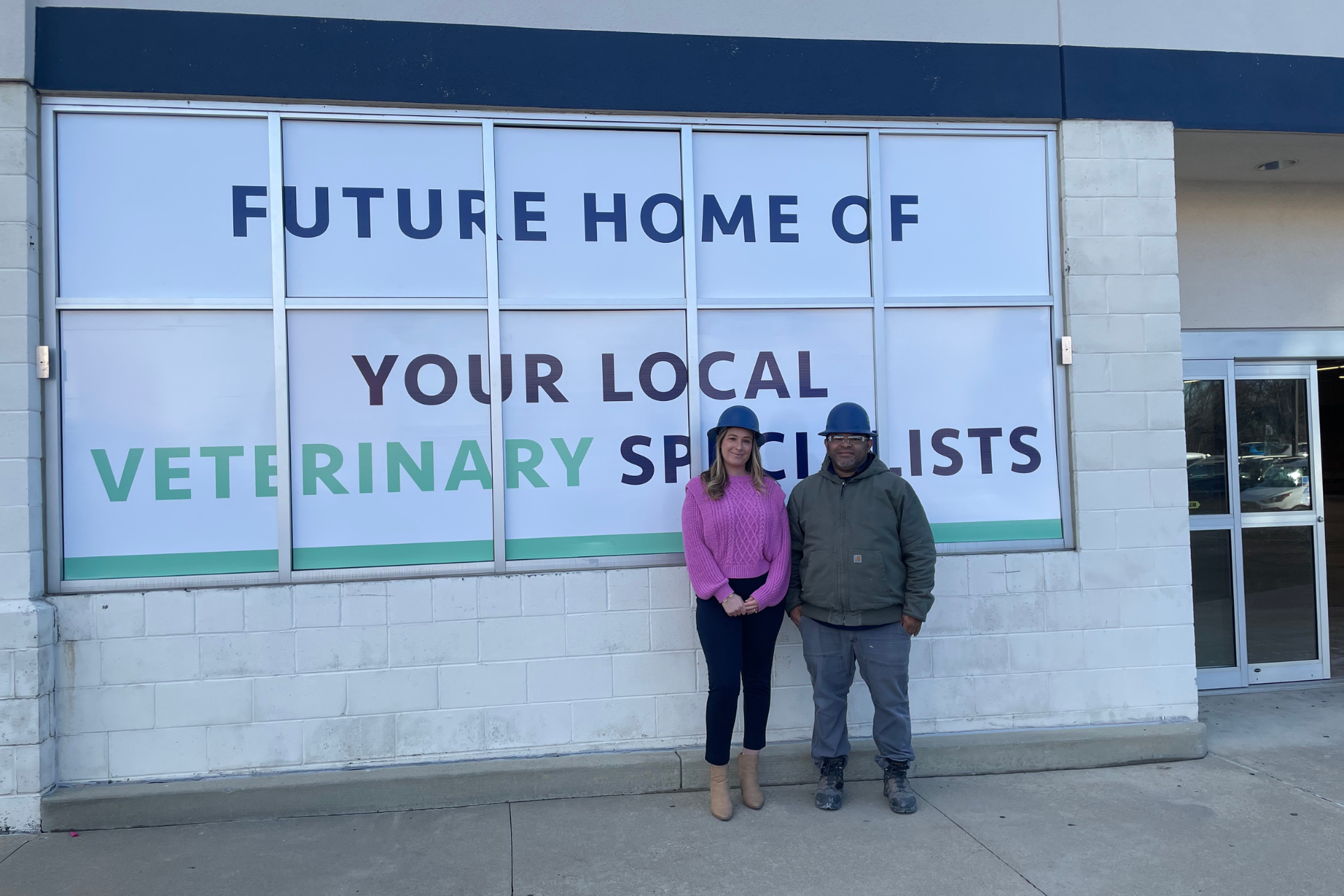
One thing that’s not trendy is repeat business. We consistently deliver the kind of service that keeps clients coming back. Our focus on building relationships and exceptional communication provides the kind of service that’s tough to beat in this area, and impossible to leave. We projected – and have seen – that the majority of our work is repeat business and referrals.
We used to think that the pandemic represented the biggest changes we would ever experience in our business, but 2023 has shown us that things are continuing to change – fast. Our ability to adjust and move on is a source of strength for HBW employees and clients. Look for more of the same for the rest of the year and beyond as HBW grows.
To learn more about our sectors and recent projects, visit our Market Sectors page on our website. For those interested in joining HBW Construction, visit Careers.
Handling emergencies is part of the job, but it’s a largely preventable part. At HBW, we always prefer seeing our customers during preventative maintenance visits rather than on emergency calls. Decades of experience have proven to our Services Division that preventative maintenance can save the day – and your budget.
If you’re a property manager or owner, consider the five ways preventative maintenance benefits your property operations.
1. Manage Costs
Property managers and owners keep an eye on the books at all times, so know that scheduled maintenance visits are always cheaper than emergency repairs. Having HBW trades out to help maintain all aspects of your property, from critical systems like HVAC, plumbing, and electricity, to the structure itself with concrete, roofing, or drywall, can control costs and inform future needs – so you can anticipate and budget accordingly. Our skilled craftsmen can watch or fix the small stuff before they turn into big problems.
2. Extend Use and Increase Value
If you want to protect your investment and extend the lifespan of your property, preventative maintenance is the way to go. We can attest to properties that look brand new despite being decades old and systems that operate perfectly well beyond their lifespan. Our tailored programs account for your specific use and environment to prevent excessive wear and tear and the need for early replacements.
3. On Your Time
Until there’s a crystal ball that lets you see when you’ll have a breakdown or need repairs, the next best thing is the HBW Services team. Our experienced crew schedules service on your time, avoiding emergencies, downtime, and tenant disruptions.
We’ve found that preventative maintenance can also help properties avoid supply chain woes by anticipating when parts or materials will be needed and procuring them ahead of time or just in time. Imagine tearing out an aging electrical panel only to find that a new one won’t be available for 6 weeks or promising to replace light fixtures but not being able to get matching ones because of delivery delays.
4. Optimize Operations
A well-maintained property is an efficient property, saving on utility costs – and management headaches! It’s also safer and more environmentally responsible.
If you have a leaky refrigerant line, you could call any HVAC company to get the system refilled twice a year, but you’d still be polluting the environment while the unit performance degrades and eats up your electric bill. HBW’s preventative maintenance plan would identify the leak during a system cleaning and check-up and get it fixed properly, saving repeat visits, refrigerant costs, electricity usage, and the hassle of it all.
5. Satisfy Tenants
Keep tenants happy and healthy with preventative maintenance. Everyone will appreciate the commitment to quality and attention to detail that HBW brings to a property. Our team can act as an outsourced maintenance department or supplement your team, reducing your outstanding to-do list, providing consultative and diagnostic services, and fulfilling tenant requests for improvements or changes.
We stay on top of trending needs. Our Service team responded quickly to properties that needed air cleaning systems or physical barriers during the pandemic.
Preventative maintenance works best when combined with a comprehensive approach to property management. HBW Services division brings the same professionalism and experience to maintenance projects (even small ones) that we use for construction.
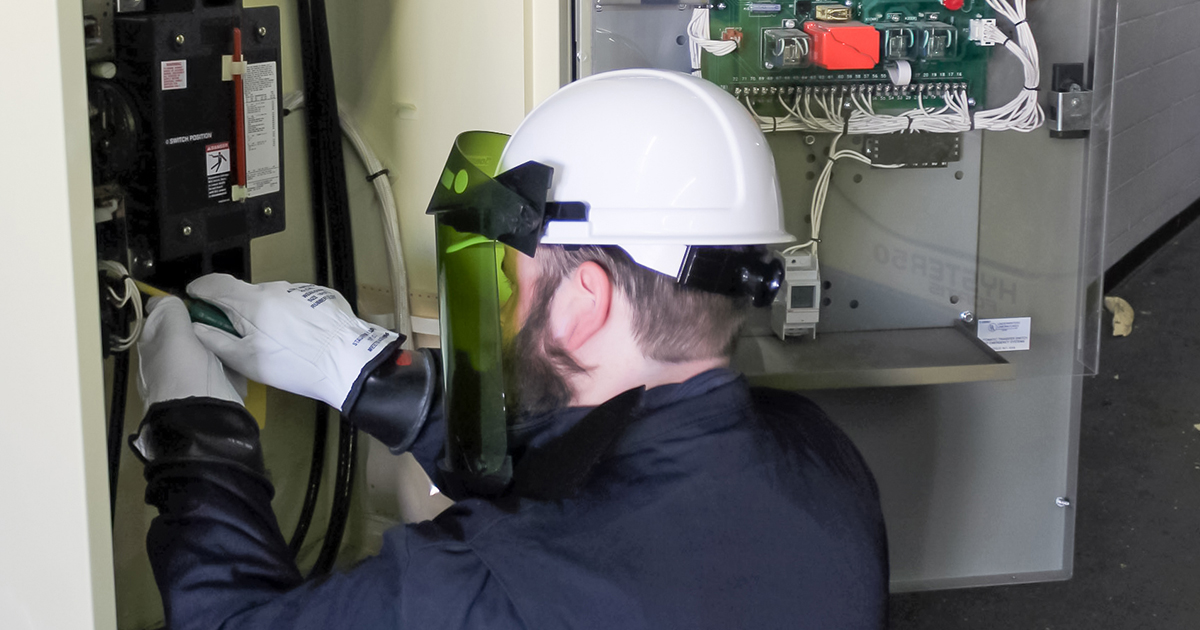
We often hear that clients consider HBW Services to be their most valuable on-demand resource because we are a one-stop resource for all property needs. The range of services we cover is extensive, from one-time service calls to preventative maintenance programs and small maintenance tasks and finish work to complex HVAC and electrical projects. Our skilled team of Project Managers, Estimators, Carpenters, Technicians, Foremen, and Certified Electricians have extensive experience, offering you the convenience of expert diagnosis and a quick resolution. Most importantly, because of HBW Construction’s large footprint in the region, our teams are nearby, often at a service call in the next town over or doing a build-out in a neighboring building. And for those problems that can’t wait, our Emergency Services are available 24/7.
Meet with one of our project managers to integrate preventative maintenance into your property management operations. Visit the HBW Services page to learn more.
According to the Occupational Safety and Health Administration (OSHA), 80 percent of workplace accidents are caused by behaviors, and 20 percent are caused by unsafe conditions. Recognizing these dual challenges has shaped the way we hire, train, support, and verify safety on the job.
HBW views safety as an all-or-nothing issue – you’re either 100 percent all in, or you’re unsafe. It sounds a bit dramatic, but we see job site safety as a sign of respect. Respect for our workers, respect for our clients, and respect for our craft. For HBW, doing the job right means doing it safely.
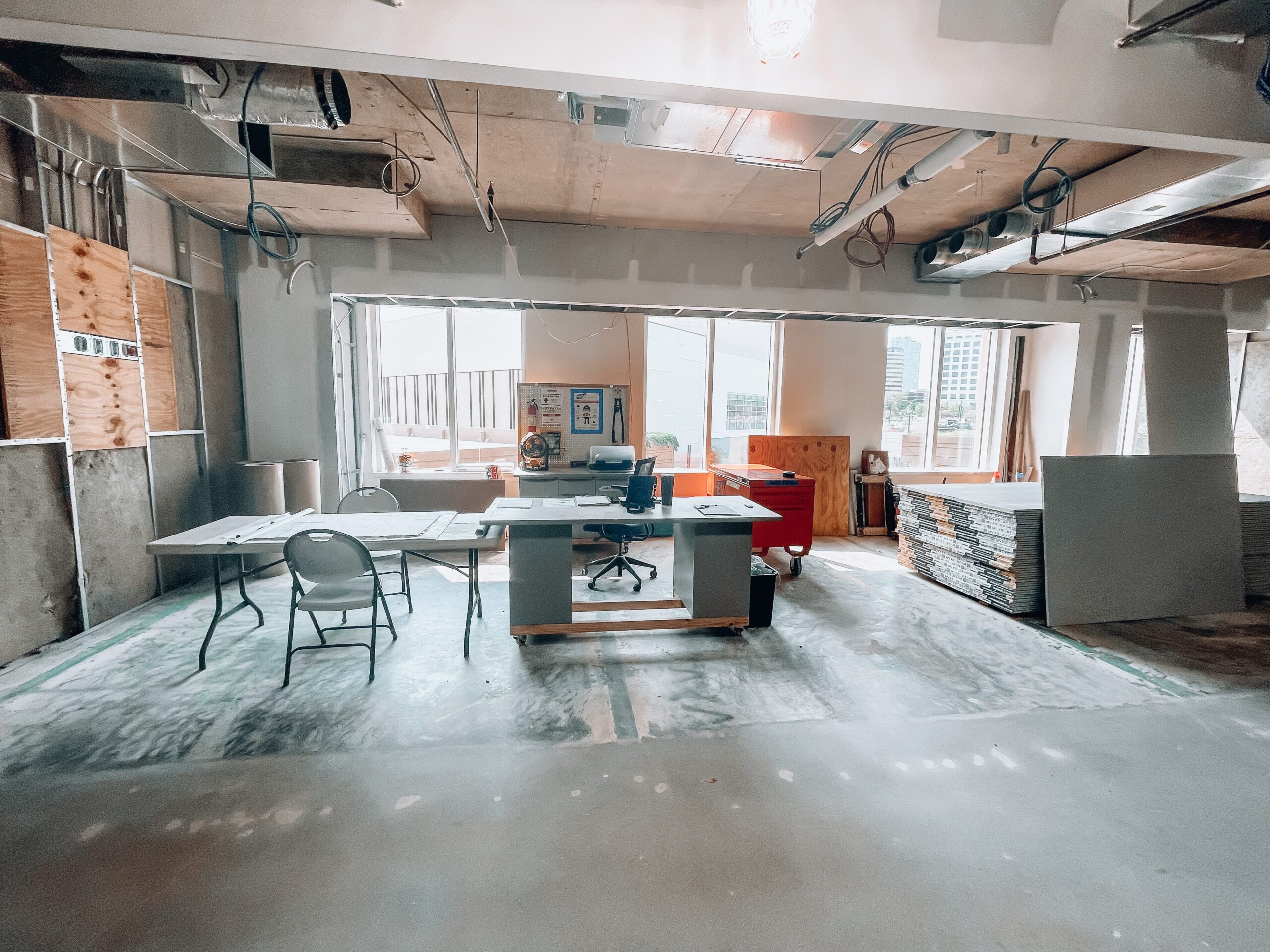
Safety, from the top down
Safety at HBW starts at the top and trickles down. We train all of our superintendents to uphold our level of construction safety. No matter their experience level, we have new superintendents shadow a senior superintendent team leader for weeks, learning our expectations for safety in every facet of the role, from following guidelines to communicating with staff. We have even created a unique trainer position to provide instruction and mentorship for those moving up in our ranks. Our investment of time and resources sets us apart from other companies in our region.
All new employees are required to go through HBW Construction’s safety orientation covering safety prevention, procedures, and response measures, setting the tone for safety awareness. Our subcontractors receive our safety manual and policies too. Our expectation is that they will arrive properly equipped to do their job with personal protective equipment (PPE) and proper tools – but we don’t leave anything to chance. Our superintendents are responsible for verifying their readiness, preparing them to enter and work on the construction site, and alerting them to any special hazards or job requirements.
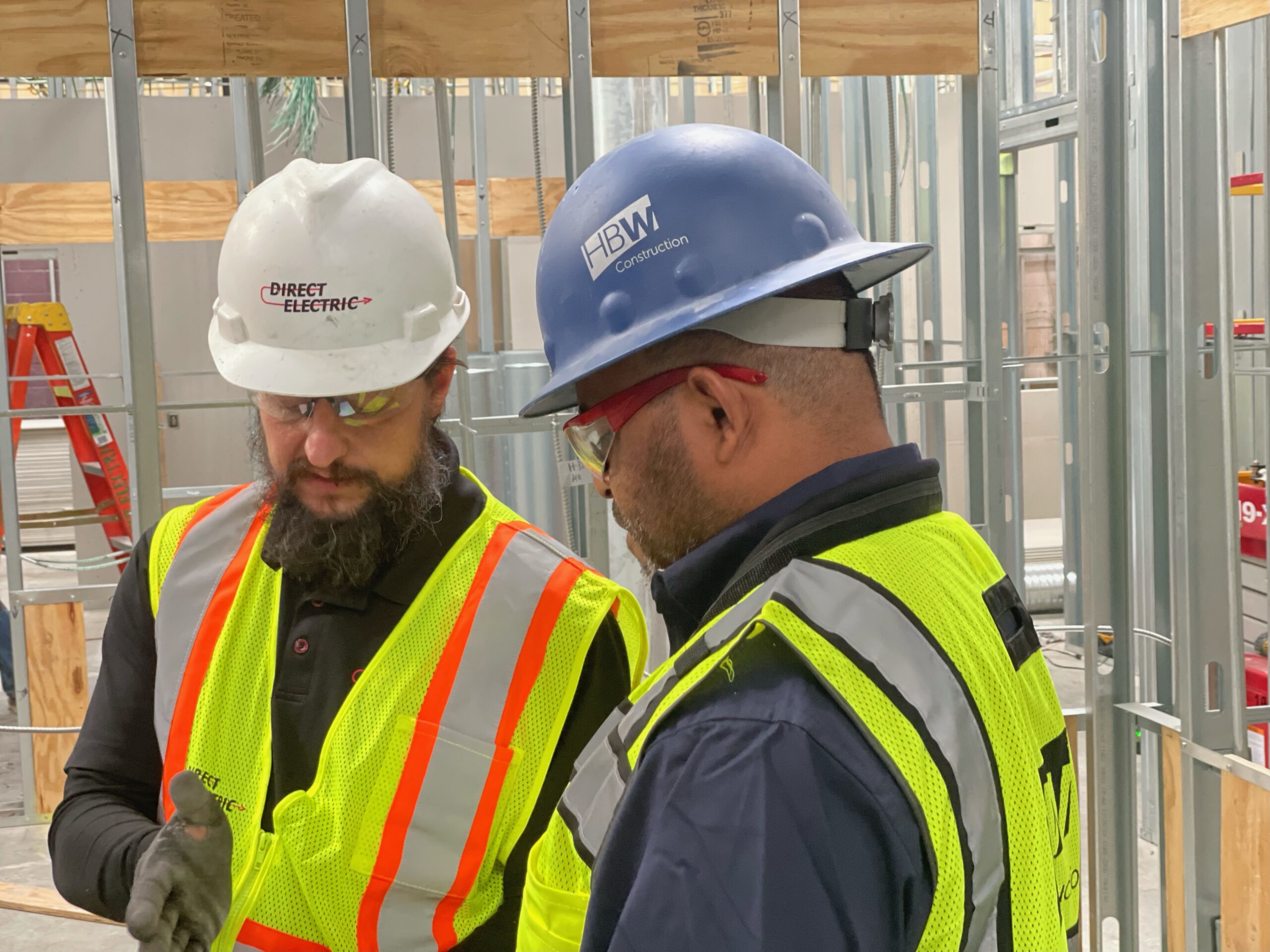
Big picture, small details
We’ve found that planning is key to safety. By thinking through the job, the people, the activities, and the risks, we can ensure everyone’s properly prepared to do their job. It is our way of gaining control over the 80 percent of safety risks that are the result of behaviors.
One challenge is that safety comes with infinite amounts of information. How do we know we’re handling every situation correctly? Following the latest regulations? Doing all that we can? HBW employs a safety consultant to supplement our own extensive knowledge of safety protocols and procedures.
The consultant helps us look at the big picture – driving a culture of safety – and drill down into the smallest details, including advising us on special safety processes for unique situations or new equipment. OSHA protocols can seem time-consuming and arduous, especially with tight construction schedules, so having a safety expert on hand keeps everyone focused on doing things right by doing them safely.
The construction industry is also constantly changing. As the industry learns new information, our training and the expertise of our safety consultants, help us apply it to our work before OSHA regulates it so our people have the best possible working conditions.
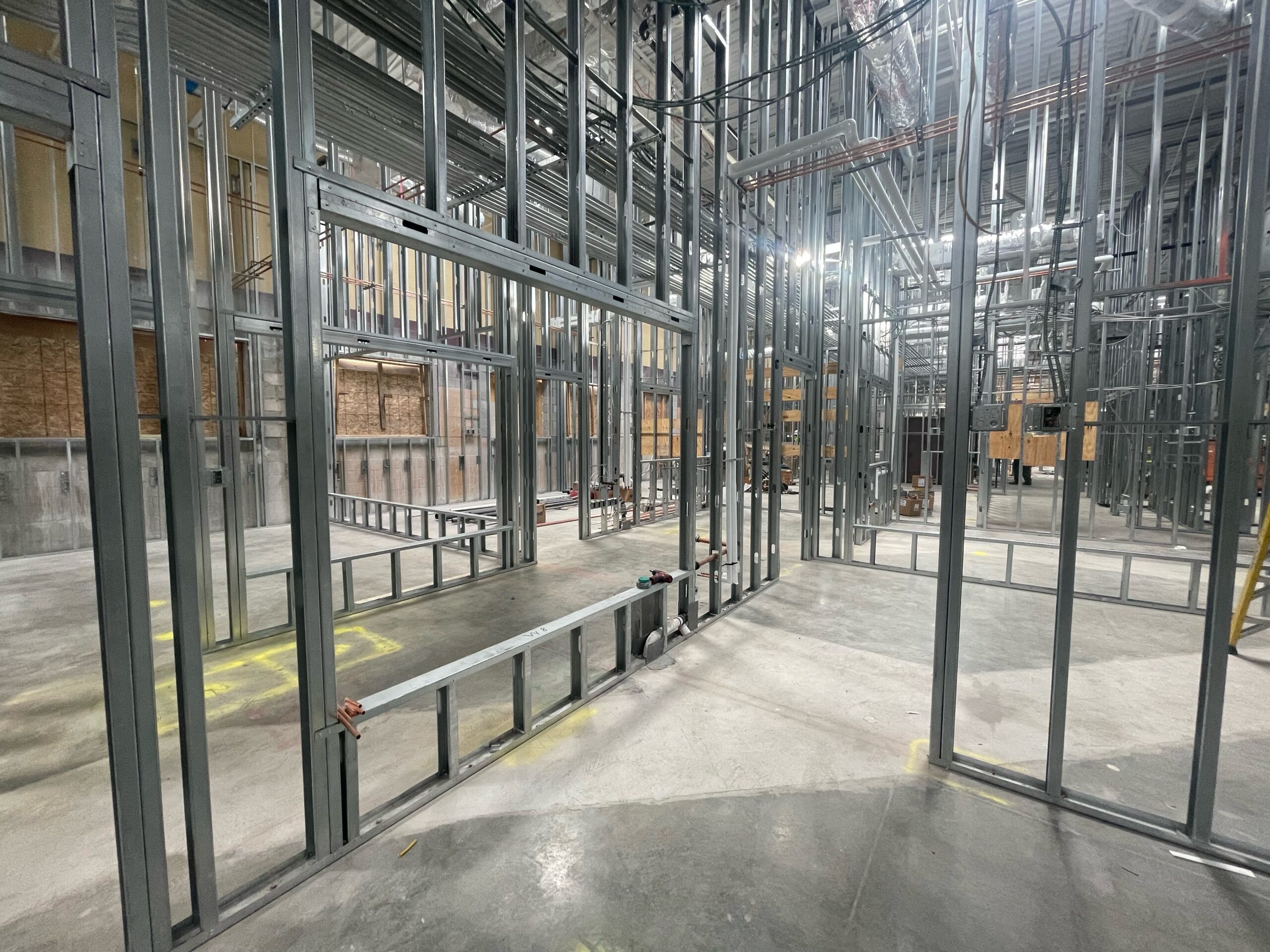
Trust but verify
Our safety consultants aren’t just there to advise, we also ask them to conduct mock OSHA inspections of our job sites – to verify that we are doing things correctly. These visits highlight any deficiencies so immediate action can be taken to improve.
Our Field Operations Coordinator schedules five safety visits to job sites each week. Jason Sears of Diversified Safety Services, a certified Construction Safety and Health Technician, walks the site with each Superintendent, using OSHA checklists and taking photos to help them recognize and mitigate safety issues. Jason’s keen eye catches problems in the making – so they can be addressed immediately and systemically – applying what we learn on one job site to all of our sites.
“HBW has a true dedication to safety that reflects how they feel about their employees, their subcontractors, and their clients,” says Jason. “Their work might not attract the attention of local state or federal compliance officers from OSHA because they don’t have a giant crane poking into the skyline, but internally they have the expectation that every part of the job will be done perfectly. Knowing our partnership helps them achieve that means a lot.”
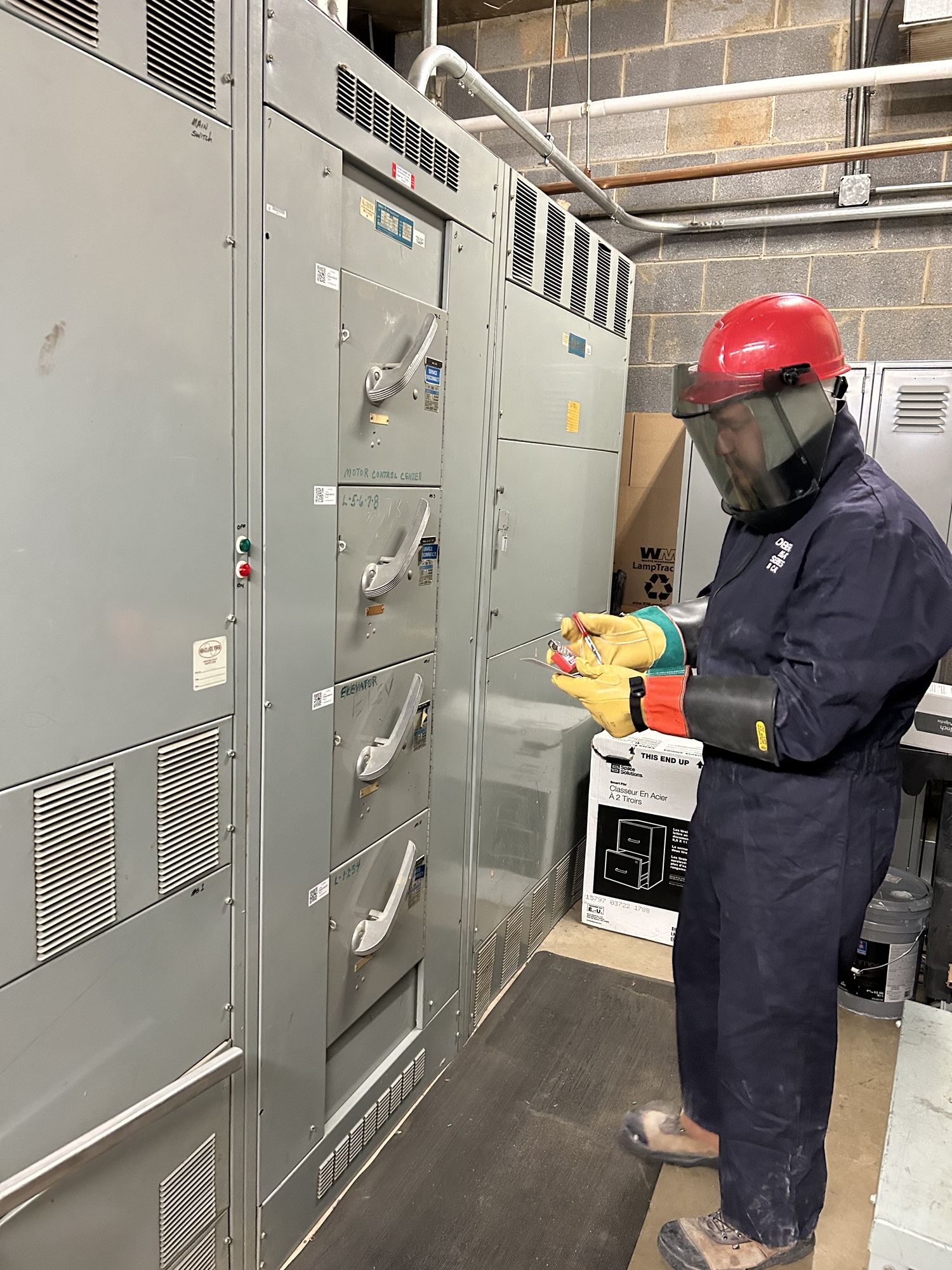
Right on time
HBW job sites have signage that states our safety guidelines, but we know that written words aren’t enough to keep everyone safe. That’s why our Superintendents conduct Toolbox Talks. These important meetings can be held daily, weekly, or spur of the moment. They gather everyone on the job site, have them sign in, and then go over our safety standards, spelling out how things should be handled on the site.
Reinforcing safety in the moment makes a difference. It leaves nothing to chance. If a supervisor has jackhammers in use, he or she may do a quick Toolbox Talk to discuss ear and eye protection for those doing the task – and those nearby. Plus, they can discuss how they will sequence work to keep everyone safe.
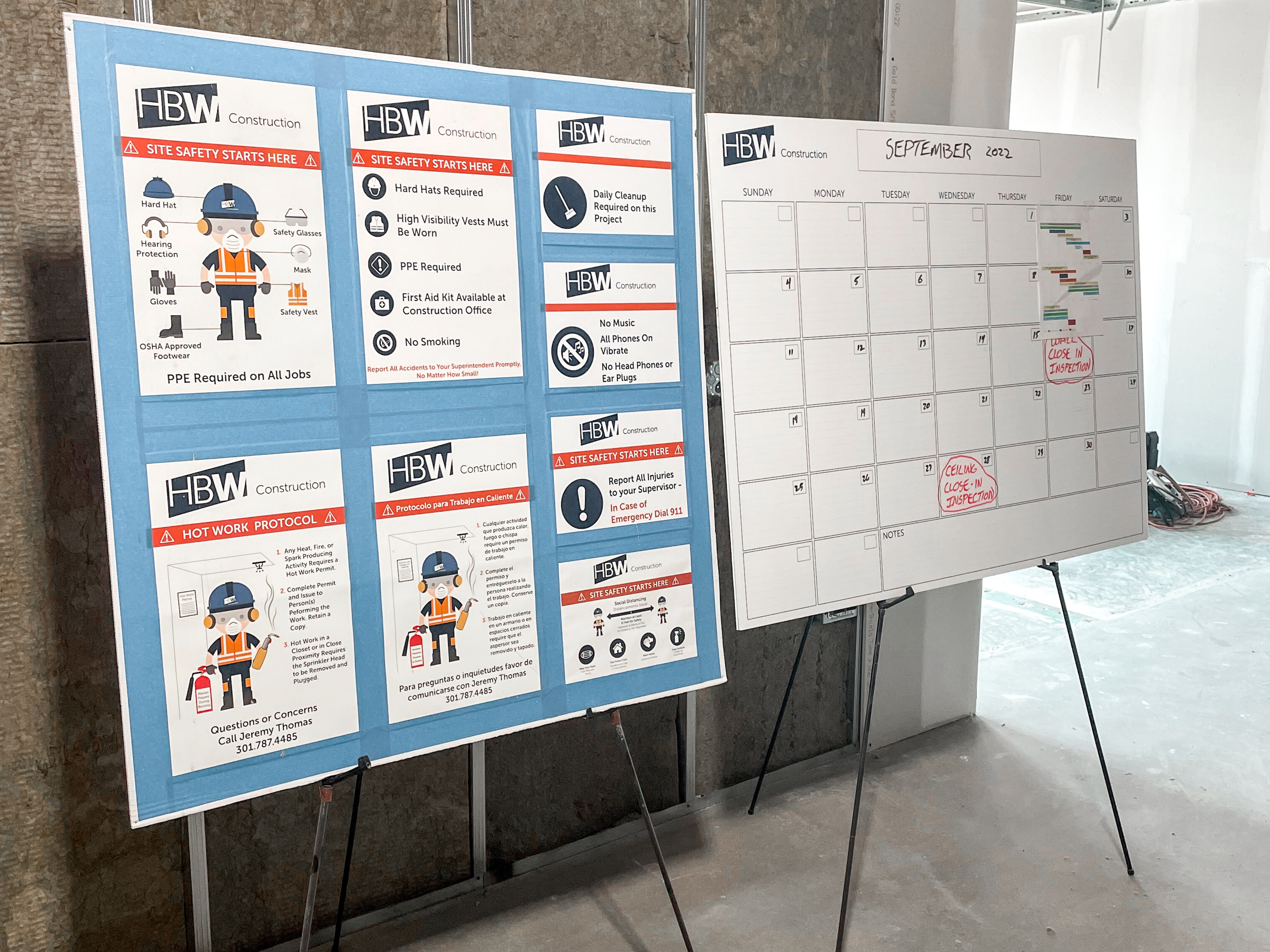
Industry involvement and leadership
HBW Construction has a long history of involvement with construction safety organizations and leadership in our industry. We are a part of the Maryland chapter of the Associated General Contractors of America’s (MDAGC) Safety Group. They are a resource for OSHA training courses, first aid certification instruction, and industry best practices. Our involvement is a clear sign to our subcontractors and our clients that we are dedicated to safety.
Significantly, the AGC recognizes safety efforts with awards, incentivizing general contractors to up their safety game and highlighting those companies with few or no accidents. HBW was recognized in 2016, 2017, 2018, 2019, 2020 and 2021 for the AGC Safety Excellence Award. This award is given to GCs with a combined incident rate below the Bureau of Labor Statistics average.
Quality goes hand in hand with safety – it’s how we get the job done during Construction Safety Week and every day.
Learn more about HBW’s quality control program on our website.
HBW Construction built two of the newest Chopt locations in the DC-Metro area, adding the chain to a growing list of restaurant construction clients who rely on our unique formula of people, processes, and relationships. Construction on these types of projects isn’t cookie-cutter or routine, and that’s where HBW shines.
Scheduling: A sprint to the finish line
The Chopt locations in Arlington feature custom millwork and beautiful ceramic tile throughout the space. The look is nothing like what you’d find at a standard tile store – it was custom ordered from suppliers out of state and internationally. The story of sourcing and installing supplies like this illustrates a common challenge with restaurant construction: it’s a race against the clock.
While most of our builds start with a schedule developed by HBW’s experienced team in collaboration with subcontractors and suppliers, restaurant build timelines are typically based on the end point – when the restaurant needs to open to start bringing in income. Marketing materials, grand opening events, and even hiring employees all require precise delivery. But specialty building suppliers often work on their own schedules, adding challenges to the construction processes.

HBW strategically builds a project schedule that minimizes time spent in the field and juggles the requirements of each trade partner. We sequence the schedule in a way that enables all trades to work together effectively, including coordinating access to the space, which is often relatively compact and surrounded by other active retail businesses.
Uniquely, restaurant projects require coordination with multiple outside vendors, including kitchen equipment, refrigeration contractors, IT and security vendors, interior and exterior signage vendors, decorators, and more, creating a construction timeline that is often a sprint from beginning to end. HBW takes ownership of managing these vendors and handling any issues or delays with an eye toward the project completion date.
The process becomes even more seamless with each repeated project, and as our ability to anticipate challenges grows with every build. Our superintendents consistently apply what they’ve learned, like how to manage delays for tile in Customs or extensive slab drilling for plumbing installation, to the next schedule. Franchises and chains are also constantly evolving their design, so while projects might be similar, each one remains unique.
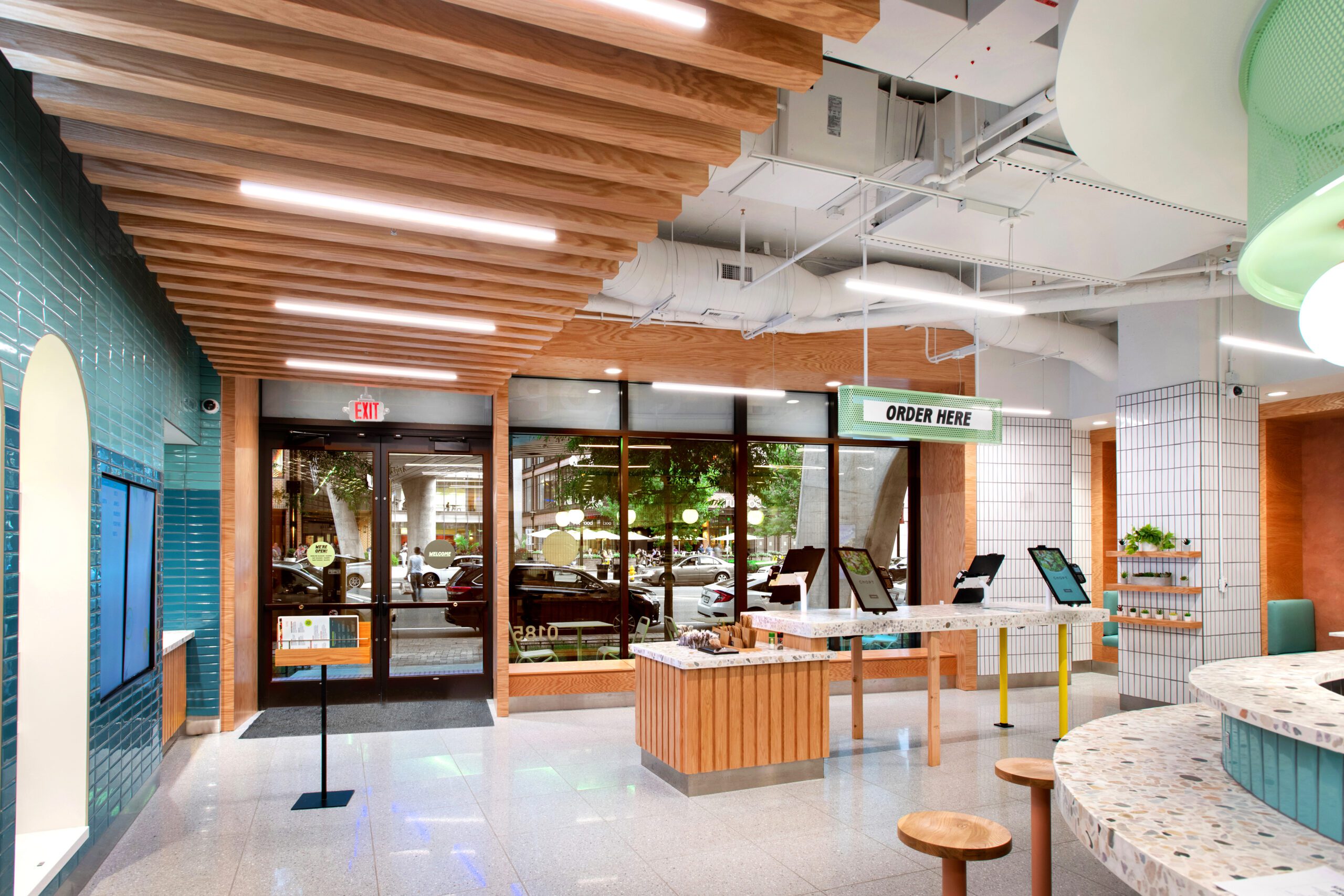
The A team
HBW has a reputation for having passionate people on our team. For restaurant construction projects like Chopt, having the right people in each role is critical. These builds demand exceptional attention to detail in order to create a consistent brand look and feel. Being passionate about a project means everyone at HBW takes responsibility to make sure the client is happy, from those on-site to those back in the office.

Our client relationships are not one-and-done. We invest in each connection so we can keep doing work for them – keeping things on schedule, on budget, and handling the inevitable hiccups. We count on our superintendents to use their experience and judgment in the field to make quick decisions and resolve issues before they turn into major problems. It’s also their job to keep the client in the loop and manage expectations.
Relationships with our subcontractors are also important since they often play a major role in our projects. HBW works with an experienced and dedicated team of subcontractors who are held to a high caliber of work. We ensure they are motivated to complete projects on time and within budget. In fact, 90 percent of them have worked with HBW for at least five years, reflecting our emphasis on repeat business.
“Communication is the cornerstone of construction”
Chopt Creative Salads is based in New York, so they counted on HBW to be their eyes and ears on the job sites throughout the process and to manage the day-to-day relationship with the landlord and nearby tenants. That trust is what distinguishes HBW from others. In fact, one of the partners we met through Chopt recently reached out to us to bid on another project – he knows we’ll do the job to his high standards.
Trust is built with communication – and results. We’ve excelled in restaurant construction because we understand that these projects require more touches than other kinds of builds. Managing all the variables under a time crunch, and keeping our clients in the loop while we do it, takes effort and skill.
We encourage you to see HBW’s work for yourself. Visit the Chopt Arlington locations in Ballston and Rosslyn. Each build pops; they’re beautiful restaurants and we are proud to be a part of their growth story.
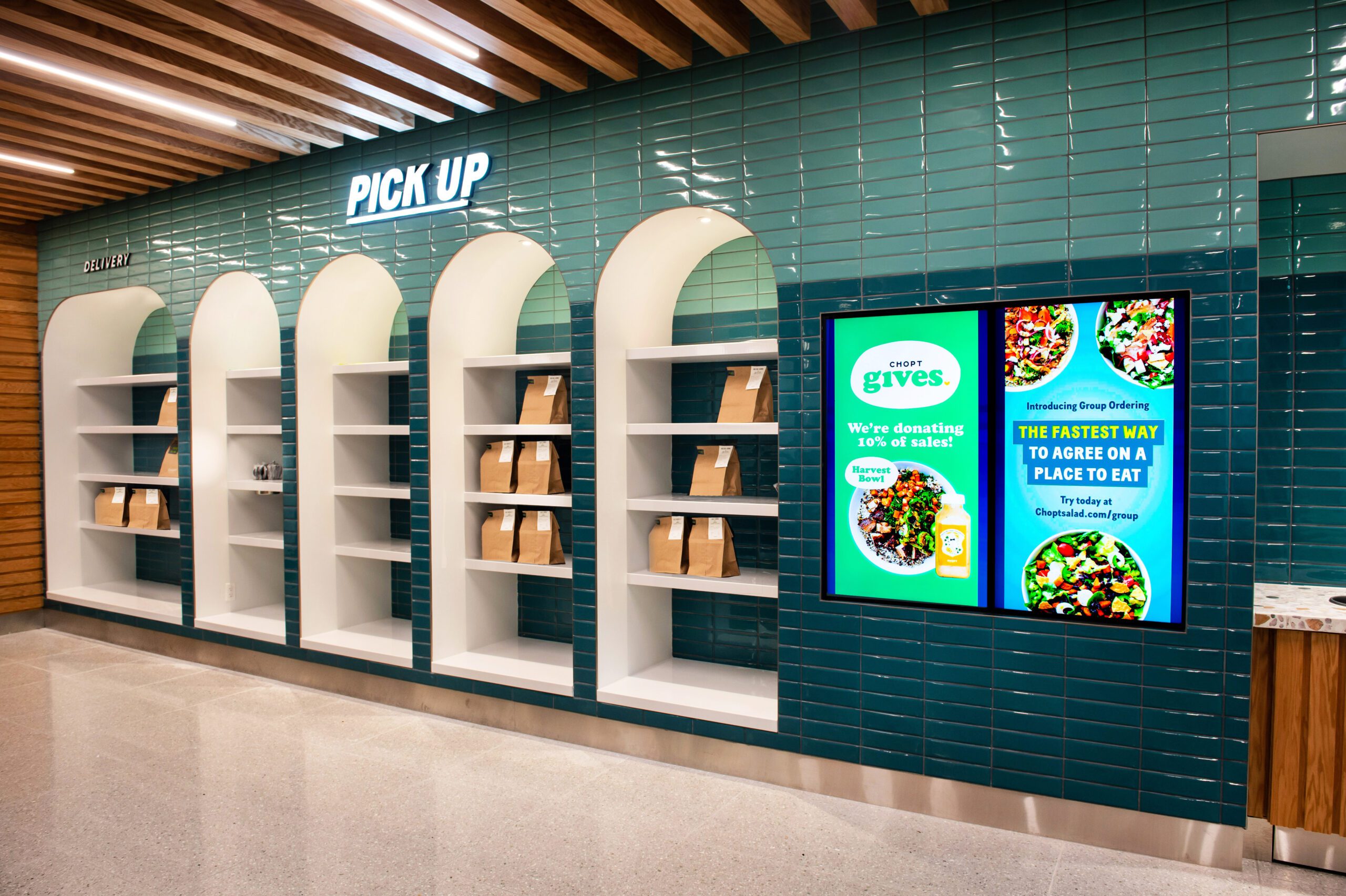
To learn more about HBW’s experience in restaurant construction, visit Market Sectors on our website.
According to the Bureau of Labor Statistics, there has been an increase in women joining the construction industry in both field and office roles since 2016. As of August 2022, 14 percent of construction workers nationwide were women. In fact, The Washington Post reported that the highest share of women in construction was here in Washington D.C. at 17.6 percent.
HBW strives to set the bar even higher – women now make up 26 percent of our workforce. We had our first female project manager in 2005 and our first female superintendent in 2019. This year we also announced our first female vice president. Did you know women manage more than $56 million in HBW projects across our business?
Economists suggest that the increase of women in construction is the result of a tighter labor market, more job opportunities, and a cultural shift that has made construction workplaces more welcoming for women.

Cultivating The Right Environment
Earlier this year, we wrote about the vision for HBW’s future and our commitment to creating opportunities, ongoing education, and continued career growth paths for all of our employees. Being deliberate about cultivating a supportive environment for personal success makes good business sense and is inclusive of everyone, including women.
Our managers lay the groundwork, helping employees set goals and envision their future. There isn’t one track that works for everyone — we look to individual employees’ talents and interests to guide their way — plus the initiative to work towards the next level. Our “growth from within” philosophy is foundational to HBW, and you’ll find many stories of employees who started in the trades or in entry-level positions and worked their way up. We have several women on staff who have grown their careers here for 10+ and even 20+ years.
The Importance of Women in Construction
Women bring a different perspective to construction, adding diversity to an industry where traditions often have a stronghold. We’ve observed that at HBW, women think differently, helping visualize multiple ways to get to the end result or improve upon a process. Women have played a critical role in cultivating relationships, helping to grow our client base and driving repeat business.
Importantly, we recognize that women moving up through the ranks inspires and motivates others. The diversity of our Executive Leadership team sends a strong message that we value talent – of any gender, ethnicity, or race.
About her Vice President title, Melissa Jones is thankful and thoughtful, “The validation and recognition means a lot to me. And it’s actually made me think a little bit differently about how I carry myself. I want to have a positive impact on those I work with and be the best mentor possible.”
Indeed, Melissa’s team was also ecstatic about her promotion. She continued, “I think it opens the door for them and what their possibilities are at HBW and in construction.”
A Forum of Support
A 2023 McKinsey Report, “Women in the Workplace,” concluded that women increasingly want to work for companies that prioritize career advancement, flexibility, and employee well-being – and will quit when their needs aren’t being met. That’s why it’s important to us that HBW Construction has its own internal Women in Construction group.
The group has its own mission and vision, conducts professional development events, and meets regularly. This year, during Women in Construction Week, the group is hosting a construction tour to visit projects that are run by female project managers.
It’s also a forum for women to share their challenges and receive support or guidance from other women who have “been there and done that.”
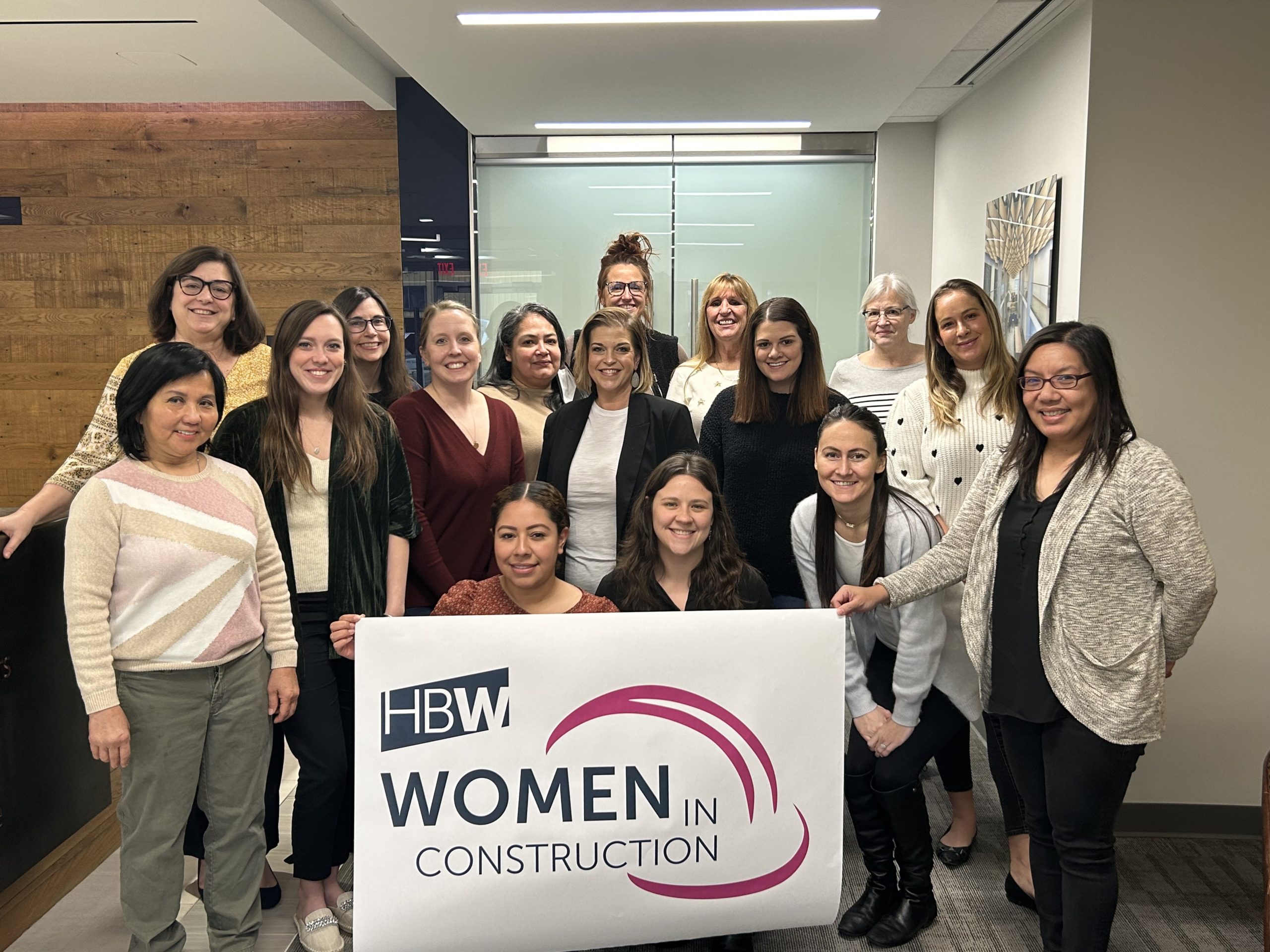
New Pathways Worth Exploring
Encouraging women to consider a career in construction includes educational opportunities and shining a light on jobs that appeal to their many specific and individual talents and interests. We advise other women to have an open mind about construction. Many picture bulldozers and dump trucks when they see a construction company name on a job posting, but that’s not the whole industry, and there’s a business side to every construction site.
HBW Construction isn’t a brick-and-mortar builder, but it is a fast-paced business that is strategic about growth, making it ripe with opportunities for women.
Melissa took a leap of faith coming to HBW. She was burned out from her job as the director of a busy preschool but had a strong background in operations and juggling multiple priorities.
“I didn’t really know anything about construction, but from the first moment I came in for the interview, I could tell the people were really genuine and really had a passion for the work. I’ve been here nine years, and it still feels brand new. I have such comradery with our team and enjoy how different each day can be.”
Kelly started as an entry-level marketing assistant. “People were very supportive from day one. I know it’s cliché to say, it feels like a family here but that’s exactly how it feels. I am given the trust and flexibility to do my job how I see fit and am valued for that work. That’s really important to me.”
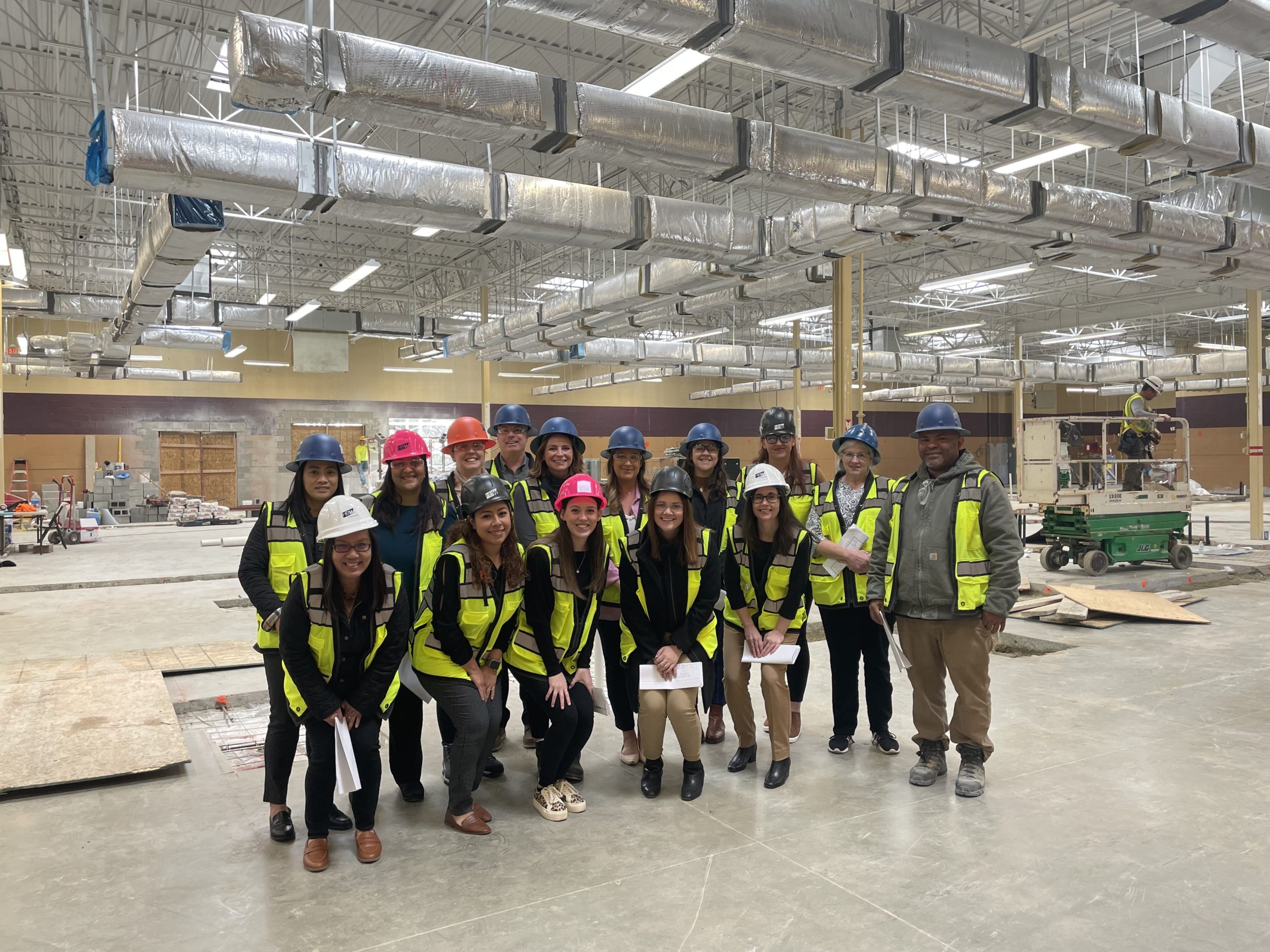
We asked other women at HBW to share their vision for the future of women in construction.
“I would love to see even more women in project management and team executive roles.” Project Manager, 9 months with HBW
“I would like to see women treated as equals 100% of the time in this industry. We are just as smart, organized, strong, and capable, if not more so, in some cases.” Senior Project Manager, 5 years with HBW
“I hope to see women in leadership positions continue to grow and more women in the field at HBW.” Marketing Manager, 10 years with HBW
“For a long time, the industry was a little rigid regarding how and who should fill specific roles. I hope to see more companies retain their female employees by giving them the opportunities they deserve.”Digital Marketing Coordinator, 8 years with HBW
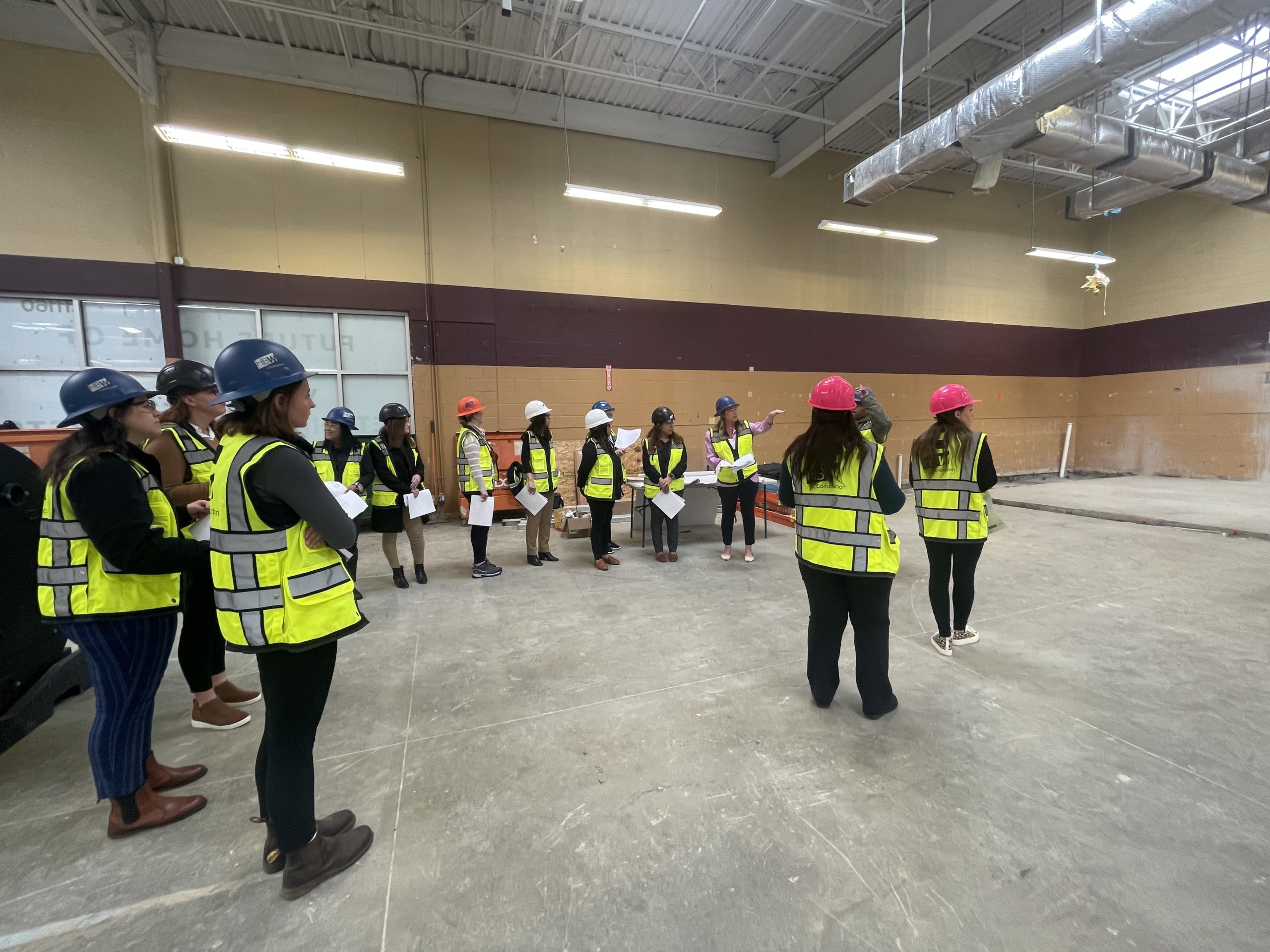
These visions are within reach and part of a larger effort. Last year, U.S. Secretary of Commerce, Gina Raimondo, announced the Million Women in Construction Initiative to double the number of women in construction — from 1 million to 2 million — over the next ten years. The industry is pushing to make it happen by supporting organizations like NAWIC, the CREW Network, and Women Building Washington.
If you want to explore career opportunities in construction for women or be part of HBW’s growth story, visit www.hbwconstruction.com/careers, or contact Melissa Jones 301.424.2900.
At HBW, we believe that learning never stops; an inquisitive mind and a willingness to learn are essential in an evolving and increasingly technical industry.
To help our colleagues better understand the processes for budgeting and scheduling, HBW Construction has developed two continuing education courses: Budgeting 101 and Scheduling 101. These courses are taught to architects, real-estate leasing brokers, construction managers, and others during construction lunch and learn sessions featuring HBW’s own experts.
Having courses that earn professional continuing education credits reflects the quality of our material and our instructors. Our coursework is accredited by the American Institute of Architects (AIA). Truthfully, we don’t know of any other contractor who teaches a class that earns continuing education credits.
Our team of experts work with budgeting and scheduling concepts and tools daily, which means that we are very up-to-date on costs, supply chain issues, design trends, and customer concerns, making our classes appealing and immediately useful.
Budgeting and Scheduling
Budgeting 101 teaches students the means, methods, and best practices used for quantity take-offs and unit pricing strategy. Gaining a better understanding of the construction budgeting process allows designers and others involved in planning to provide the details an estimator needs for a more complete and accurate budget.
We offer our construction budgeting course because we believe realistic budgets are a collaborative effort, whether you work with HBW or another company. The market has become very cost-conscious, and everyone involved wants to know – down to the penny – how much things are going to cost. Ballpark numbers leave too much room for error. HBW does 40-50 hard bids and 20-30 budgets a month, so we have a better idea than most of what design choices cost.
For our colleagues in leasing, having a realistic idea of what they can provide within the tenant improvement allowance (TI) impacts marketability, lease prices, and even tenant relationships. Our course can make the difference between a tenant moving into a space with expectations met and excitement or over-budget and disappointed.
As part of our construction budgeting course, we give students the tools they will need to understand and speak the language of an estimator to more accurately provide cost analyses to their clients for different build and finish requirements, including our own unit price comparison chart, project type comparison chart, and budget request form. We demonstrate how we build a budget based on real plans.
Scheduling 101 is taught by HBW’s scheduling pros – leveraging our experience to help future projects run smoothly. The course teaches the Critical Path Method of scheduling used in our operations. Like budgeting, construction scheduling helps set expectations with clients and our subcontractors far more effectively than looking at a calendar.
The construction scheduling course includes capturing all the steps in a build, how much time certain tasks will take, scheduling trades to do the work, and how long it will take to procure everything for the project. Because we’re familiar with what can go wrong during a build, we demonstrate how to be proactive and plan for things that might cause delays. We also explain the concept of floating, which allows some shifts in a schedule.
Our construction scheduling course uses a real example the students can relate to, starting with the due date and working backward. Students are taught to read a schedule, which is often more important than knowing how to build one themselves because it can help them understand a project’s status at a glance.
Enhance your knowledge with HBW Construction
For more than 50 years, our mission at HBW Construction has been to deliver highly personalized service and build trusted relationships. Offering budgeting and scheduling courses allows us to share our expertise with other industry professionals, helping them become better partners throughout the construction process. And that benefits the end-customer experience by accurately managing expectations for the cost and timing of construction.
To learn more or to schedule an HBW class, please email HBW’s Vice President, Patrick Foley pfoley@hbwconstruction.com.
Thanks to a quick pivot early in the pandemic and smart practices that help negate supply chain woes, the outlook for our business looks promising. In fact, we are projecting growth for 2023 that would restore us to near pre-pandemic numbers. Our progress, and our path forward, are the result of some key strategic moves within HBW.
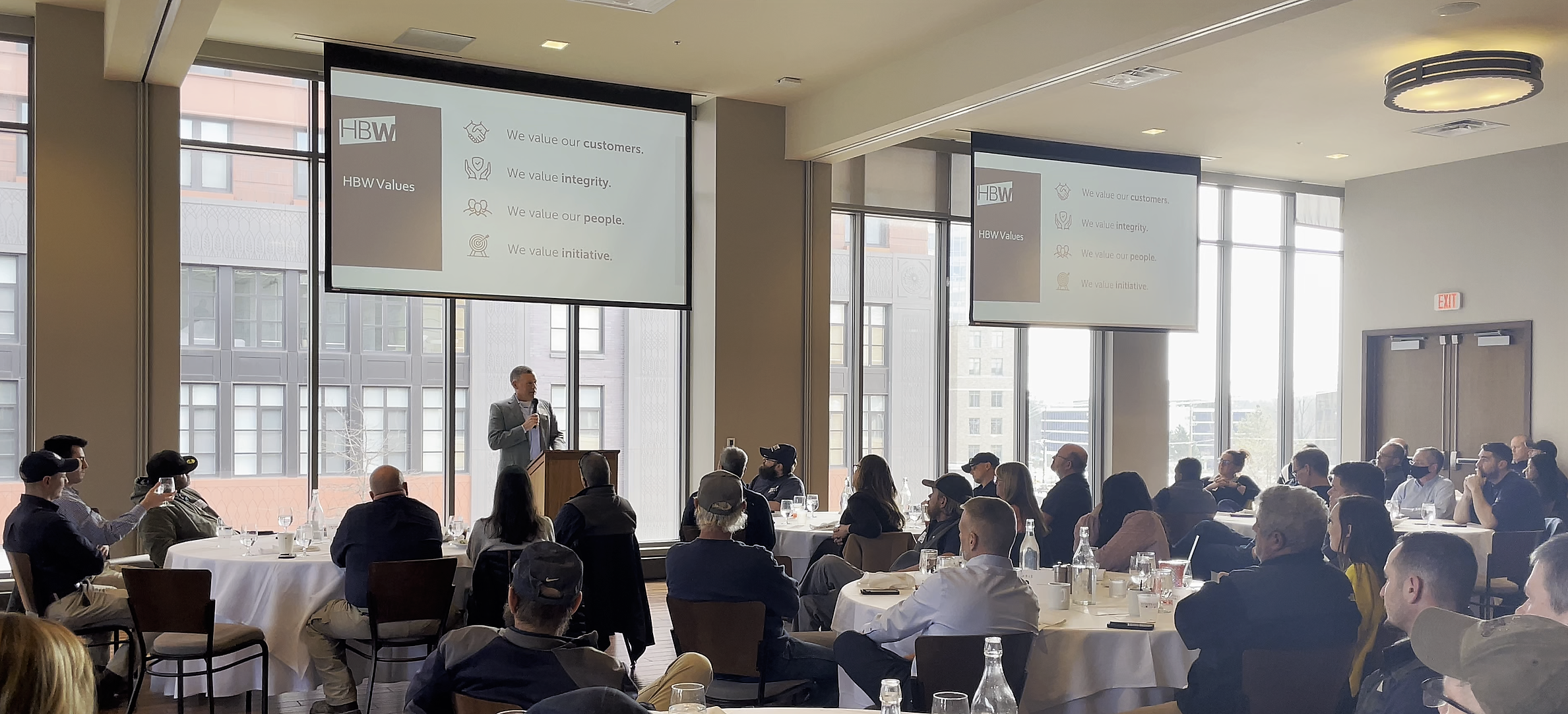
Building on a strong foundation
Three ideas describe how HBW Construction has been successful and how we intend to tackle the future. They are: integrity, understanding and exceeding expectations, and relationships.
You could say we have a secret recipe – focusing on core values has allowed us to be flexible and open to new opportunities. We have developed a strong connection with our customers, our trades, and our community. This has set us up for even greater success over the next two to three years. HBW Construction is on an upward climb.
Leadership in construction
HBW has a reputation for understanding the importance of leadership in construction. Our goal is to have the right people in the right places to serve our customers, from the field to the front office.
We’ve made some exciting leadership changes recently. Phil Scott is now the CEO, with John Leach moving into the role of President. Andre Chin Wing and Melissa Jones have both been promoted to Vice President. Jim Hirrlinger retired, having left significant contributions to the foundation of HBW.
Diversifying Work and Skill Sets
When others were downsizing during the pandemic, we looked for growing market sectors to diversify and expand our client base. Our sectors now include corporate interiors, healthcare and life sciences, education and daycare, retail, restaurants, warehouse, government, multi-family, and senior living. By adding sectors, we’ve created opportunities for HBW employees to work on new projects, develop new skills, and gain niche market knowledge.
Keeping an eye on trends
HBW identifies commercial construction trends by listening to our customers, watching business growth numbers, and following thought leadership. This helps us understand where our customers are headed and meet their needs. For example, we recognized the uptick in veterinary offices, grooming, and pet care builds to handle all the pets people got during the pandemic, and the steady increase in senior living and accessibility remodels as baby boomers age.
The pandemic brought changes that are still rippling through commercial construction. Office use has changed, maybe permanently. We’ve adjusted by helping customers reduce their footprint and add more efficient, more productivity-focused spaces, areas for collaboration, and rooms with multimedia and connectivity solutions.
Working with, not against, the supply chain
We used to be able to get many of the products needed for projects off the shelf, but supply chain issues mean we’re now having to wait weeks and sometimes months. That’s where we leverage the creativeness of our team. With alternate sourcing and different ways of tracking products, know when materials will actually arrive. Our industry has become desensitized to protracted schedules and customer disappointment. If we can improve the process even a little, through diligence and creativity, we are exceeding expectations and elevating the customer experience.
Deepening Client Relationships
Our expanded sector experience has given us the opportunity to do additional work for existing clients. Repeat clients are a good indication that we’re doing things right. We’ve recently finished several franchise locations for dog daycare and multiple restaurants for an expanding local brand.
Relationships are important to us. We get to know our customers, understand their needs, and foster a sense of teamwork as we bring their builds to the finish line. Because we live in the communities where we work, HBW employees often have the opportunity to patronize the businesses of our clients. It’s very cool to walk into a shop, restaurant or a dental office and know you had a hand in building it.
Building Careers From Within
HBW is committed to our people. We avoided layoffs during the pandemic, taking some pretty extraordinary steps to keep our team intact. That move turned out to be important as new projects started up because we were fully staffed and ready to go.
We’re also pretty deliberate about creating opportunities and growth paths and developing skill sets. In fact, many of our promotions and hires come from within our network as we recognize those who embrace learning, handle greater responsibility, or go the extra mile for customers.
To learn more about our sectors and recent projects, visit our Market Sectors page on our website. For those interested in joining HBW Construction, visit Careers.
At HBW, we are scheduling pros – leveraging our past experience to help every future project run smoothly. Our continued success is based on results, and that includes calendar management.
We use the Critical Path Method of scheduling in our operations. The critical path is determined based on activities and their duration, the sequence of activities, and the relationship between activities. Each activity directly impacts the completion date for the project. So, activities running a day late means the end date is impacted by the same number of days.
We think of it like setting up a domino course. We sketch out the big-picture vision of the schedule – what things need to get done to complete the project. That’s like laying out a course.
From there, we fill in the dominos – who needs to be there and on which days. We know that once a solid schedule is created, things cascade as each domino impacts the next, right down to the last one falling right on time.
Our scheduling and time management provides marching orders, but the key to making it all work is communication. We use day-to-day planning to set expectations with our clients and our subcontractors. The process doesn’t work if we are just showing them a calendar. What does work is having a dialog about the plan, with everyone involved providing feedback about how much time certain tasks will take or how long we need to allow to procure everything we will need.
The initial stages of scheduling are where experience makes all the difference. Often the projects that we’re doing aren’t really all that different from other projects we’ve done in the past. We know how long it takes to hang drywall, or install light fixtures, and we’re familiar with what can go wrong during a build. That knowledge allows us to be proactive and plan for things that might cause delays.
Let’s look at strategies for creating a schedule and helpful schedule tips.

Start at the end
The end is a good place to start. We like to begin every schedule by asking about the timeline the client, the tenant, or the broker has in mind – and what’s driving those expectations. From there, we can work backward, roughing in design, procurement, and construction phases in the schedule to determine if that date is realistic and possible.
Of course, you want to hit that end date but it’s more important to set expectations for what is actually possible. Once you do, you can sweat the details and be on top of following up with suppliers and manufacturers to ensure there are no delays and no surprises.
Map out and list the activities that will be required to build the project
The next step is to list out all of the activities the project requires and their duration, pulling in my construction managers and trades to make this list as complete as possible
- Reviewing the project documents
- Reviewing building requirements
- Consulting with our construction managers or colleagues who have done similar projects in the past
- Consulting with trades performing the work
It’s helpful to categorize the activities based on the structure of the schedule.
Design: All activities necessary to produce a set of documents to communicate the work to those performing the work.
Procurement: Activities that involve gathering the materials that will be needed and lead times for materials that must be ordered or built.
Construction: Activities necessary to produce the work, often subdivided into steps required by each contractor.
Relationships/Links: Understanding the relationship between activities allows you to schedule activities in order, sequencing those dependent on other work, and listing successors and predecessors for each.
Milestones and Benchmarks: These are deliverables like Concept Drawings in the Design phase or Ceiling Close-in in Construction.
By placing activities in their sequence, you’ll have created an initial schedule.
Create and refine
Scheduling is an iterative process. As the project progresses, we’ll refine the schedule based on how long activities actually take.
We use a concept called float to understand the timing for each activity. Float is the number of days that the activity can be late before it impacts the completion date. For example, rough-in electrical boxes have a Float of 0. That means the activity must start on the identified start date and be completed within the identified durations. If the activity starts late, we must either reduce its duration to complete it on time, or its end date will push, affecting other activities. Float allows us to make decisions on individual activities by showing how each will impact the schedule.
What about contingencies?
Scheduling is a delicate balance between having enough time to get everything done, and shortening time on site to avoid burning through resources. Planning helps anticipate activities that have a bigger float and limits some of the risks involved in each project.
We frontload our schedules, working ahead whenever possible so if something unexpected does crop up, we have options. For example, if light fixtures are delayed, and we have “float” in the schedule, we can consider our options: wait on installation, replace those fixtures with another product that is available, or install temporary fixtures until the new ones come in. Frontloading helps us be more proactive and less reactive, just like planning a project schedule in the first place.
Become a Scheduling Pro With The Help of HBW Construction
Benjamin Franklin didn’t work in construction, but he recognized the importance of time management for successful outcomes. We are proud to call ourselves scheduling experts. If you’re interested in learning more, HBW offers a Scheduling 101 course for continuing professional education credit. To learn more, visit, https://hbwconstruction.com.
